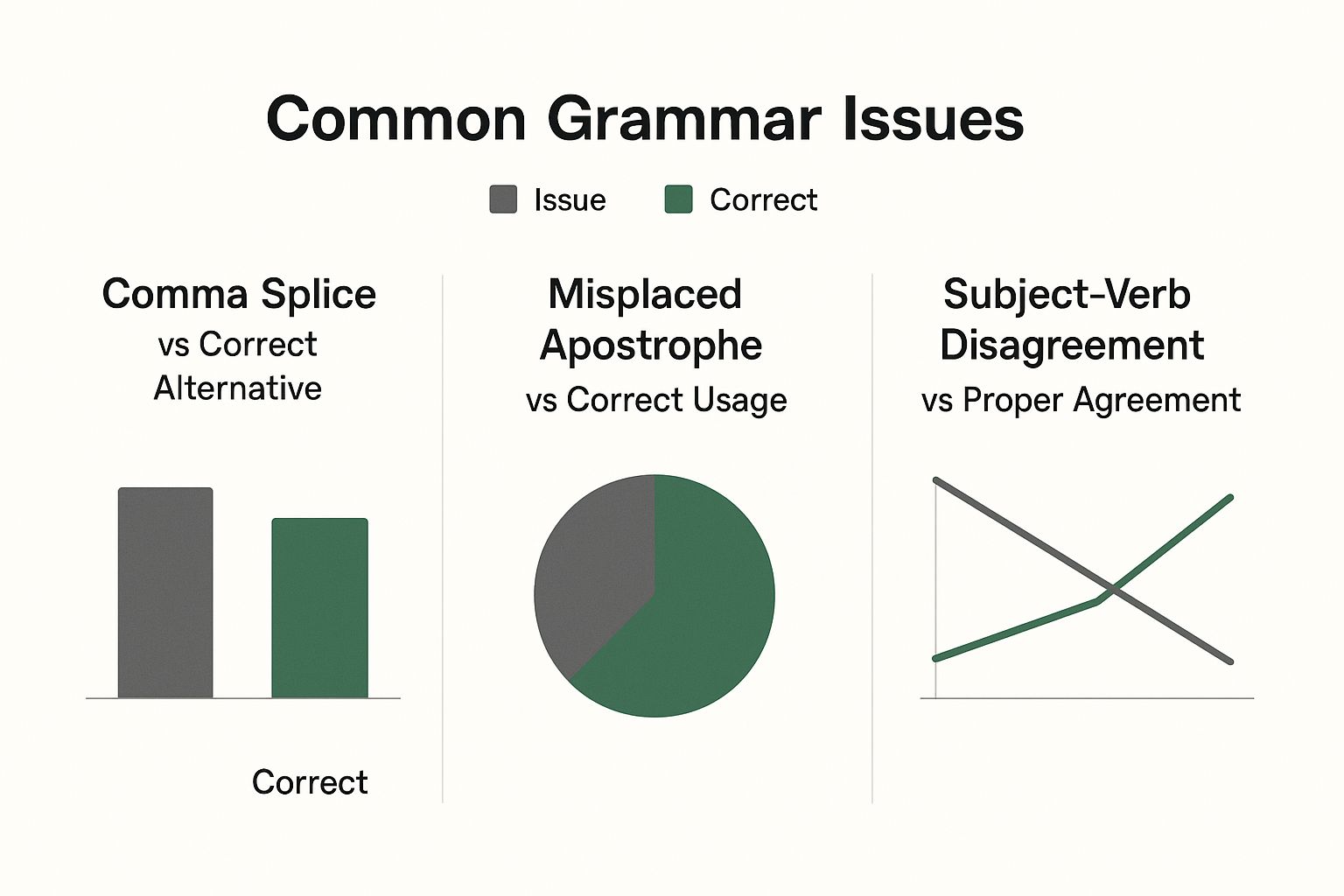
Academic Writing Style Guide: Improve Your Research Papers
June 14, 2025
Understanding Academic Writing: Beyond Boring Textbooks
Academic writing. The term itself can feel a bit stuffy, bringing to mind dense textbooks and complicated jargon. But at its heart, academic writing isn't about showing off with big words. It's about clearly and effectively communicating complex ideas. Think of it as building a bridge between your research and your reader, carefully guiding them through your findings. Every sentence is a brick, every paragraph a wall, all coming together to create a solid, understandable structure.
Why Clarity Trumps Complexity
This means clarity is king in your academic writing style guide. The goal isn't to impress with a fancy vocabulary; it's to make sure your audience understands your argument. Imagine explaining your research to a colleague over coffee. You wouldn't overwhelm them with technical terms without explaining them, right? You'd explain the concepts gradually, building their understanding step by step. This conversational approach, while still maintaining academic rigor, is the key to engaging writing. For instance, instead of saying "the epistemological underpinnings," you could simply say "the basic assumptions." That small change makes a big difference in how accessible your writing is.
Balancing Rigor and Readability
The best academic writers manage a tricky balancing act. They maintain rigorous intellectual standards while making their work understandable to a broader audience. This isn’t about simplifying your research. It's about presenting it in a way that respects your reader's intelligence while recognizing they may not be specialists in your specific area. You might be interested in How to Write Better Essays for more tips on refining your writing.
Academic vs. Other Writing Styles
Academic writing is distinctly different from other kinds of writing, like journalism or creative writing. Its purpose isn’t to entertain or report news, but to contribute to an ongoing scholarly discussion. The Wikipedia article on academic writing gives a helpful overview: The screenshot highlights key characteristics like formal tone, arguments supported by evidence, and precise language. These elements set academic writing apart from more casual or subjective writing styles.
To illustrate this further, let’s look at a comparison table:
This table outlines the key distinctions between academic writing and other styles, highlighting the unique aspects of each.
| Writing Type | Primary Purpose | Target Audience | Tone | Evidence Requirements |
|---|---|---|---|---|
| Academic | Advance knowledge, contribute to research | Scholars, researchers | Formal, objective | Rigorous, peer-reviewed |
| Professional (Business) | Persuade, inform, instruct | Clients, colleagues | Professional, concise | Data-driven, practical |
| Journalistic | Report, inform | General public | Objective, accessible | Fact-checked, verifiable |
| Creative | Entertain, express | Readers | Varies widely | Not required |
As you can see, each writing style has its own set of goals, audience expectations, and conventions. Academic writing, with its emphasis on rigorous evidence and formal tone, stands apart.
By understanding these differences, you can adjust your writing to meet the specific needs of the academic community. This understanding is fundamental to effective communication of your research and ensures your work reaches a wider audience within your field.
Style Guide Survival: APA, MLA, and Chicago Decoded
Think of academic style guides like a dress code for scholarly work. They might seem fussy at times, but they ensure everyone's on the same page, making it easier to understand and appreciate each other's contributions. APA, MLA, and Chicago are the most common styles, and while switching between them can feel like changing outfits for different occasions, understanding the "why" behind each style makes the transition smoother.
This infographic highlights how even small grammar choices can impact clarity:

Just like a misplaced comma can trip up a sentence, inconsistencies in style can disrupt the flow of academic discourse. Each style guide has its quirks, and recognizing these nuances is crucial for effective scholarly communication. These different "dialects" are used globally across various disciplines: APA in social sciences, MLA in humanities, and Chicago in history and philosophy. Each one comes with a hefty rulebook and regular updates. Discover more insights on style guides.
Decoding the "Why" Behind the Styles
Beyond simple formatting, each style reflects the values of its field. APA, common in social sciences, emphasizes dates. This is because research in fields like psychology is constantly evolving – think about a study on social media and mental health. The date is crucial because platforms change so rapidly. MLA, prevalent in the humanities, prioritizes authors. Imagine citing Shakespeare – the author's name carries significant weight in literary analysis. Chicago, often used in history, offers more flexibility, reflecting the diverse nature of historical sources.
Seeing Style Guides in Action
Here's a glimpse of the APA Style website:  This shows the vast resources available for navigating APA style, proving how vital these resources are for accuracy and consistency in academic writing.
This shows the vast resources available for navigating APA style, proving how vital these resources are for accuracy and consistency in academic writing.
Imagine citing the same source in APA, MLA, and Chicago. The differences might seem minor – a comma here, a period there – but they matter. They signal your understanding of the conventions within each field. It's like dressing appropriately for a job interview – you're showing you take it seriously.
To help you navigate the key differences, here's a quick reference table:
Style Guide Quick Reference: APA vs. MLA vs. Chicago Essential formatting differences between the three major academic style guides for citations, references, and document structure
| Element | APA Style | MLA Style | Chicago Style | Key Difference |
|---|---|---|---|---|
| In-text Citations | (Author, Year, p. #) | (Author #) | Footnotes/Endnotes | Location of citation information |
| Reference List/Bibliography | References | Works Cited | Bibliography | Title of the source list |
| Date Format | (Year, Month Day) | Day Month Year | Month Day, Year | Placement and punctuation of date elements |
| Title Capitalization | Sentence case for article titles | Title case for article titles | Title case for books, sentence case for articles | Capitalization variations |
This table highlights the key differences in citation format, source list titles, date formats, and title capitalization between APA, MLA, and Chicago. Understanding these distinctions is essential for correctly formatting your academic work.
Adapting to Different Styles
Navigating these style guides can feel like learning a new language, especially when your research spans multiple disciplines. But by understanding the logic behind each system, you can adapt effectively. Practical tools like online style checkers and quick reference guides can simplify the process. It's about being versatile and demonstrating your grasp of scholarly communication, no matter the "dress code."
APA Style Mastery: Making Social Science Research Shine
APA Style. It’s not just a rigid rulebook, but a way for researchers in the social sciences to clearly communicate with each other. Think of it as a shared language, helping us build upon each other’s discoveries. Once you grasp the reasoning behind APA's structure, those seemingly random rules begin to click.
Why Dates Matter in APA Style
In fields like psychology and sociology, research is always changing. Imagine reading a study about social media and mental health. A study from 2015 would have vastly different findings than one from 2023. Why? Because social media itself has drastically changed! APA Style highlights publication dates so readers can instantly see how relevant and recent the research is. This chronological focus helps researchers trace the development of knowledge in their field.
Author Order and Collaboration
The order of authors listed in APA Style isn't random either. It reflects the teamwork inherent in scientific work. The first author typically made the biggest contribution, with subsequent authors listed in descending order of contribution. This recognizes everyone's intellectual input and effort. This clarity fosters a sense of shared accomplishment and promotes ethical research practices.
Precision in Language: Why It Matters
Precise language is crucial in APA Style. Imagine research on a new therapy technique. Vague wording could lead to misinterpretations and even harmful applications. APA's focus on precise terms makes sure research findings are communicated accurately, especially since these findings can influence real-world choices. This protects the research's integrity and the well-being of those who could benefit from it. This screenshot from the APA Style website shows the resources available to help writers achieve this precision:  The site offers detailed guidance on everything from grammar and punctuation to bias-free language and formatting. This support makes APA Style accessible to both beginners and seasoned researchers. It's interesting to note how widespread APA Style's influence is. As of 2024, 53.6% of doctoral degrees are awarded in fields that use this style, showing its significance across many disciplines. Explore the prevalence of APA Style.
The site offers detailed guidance on everything from grammar and punctuation to bias-free language and formatting. This support makes APA Style accessible to both beginners and seasoned researchers. It's interesting to note how widespread APA Style's influence is. As of 2024, 53.6% of doctoral degrees are awarded in fields that use this style, showing its significance across many disciplines. Explore the prevalence of APA Style.
Mastering Tricky Citation Scenarios
Citations can be one of the trickiest parts of APA Style. Multiple authors, missing information, online sources, and secondary citations can be a real challenge. But if you understand the basic principles, you can navigate these situations with confidence. Think of each citation as a breadcrumb trail, guiding readers back to the original source. Accurate citations aren't just about avoiding plagiarism; they're about giving credit and letting others verify and expand on your work.
Common Mistakes and Staying Current
Even experienced researchers can slip up with APA Style. Luckily, resources like the APA Publication Manual and online style guides can help you avoid common errors. Staying up-to-date with changes to APA Style is also important. Just like any language, APA evolves, so checking updated resources ensures your writing is accurate and consistent. By continually refining your understanding of APA Style, your research can truly shine and contribute effectively to the ongoing scholarly conversation.
Presenting Data That Actually Makes Sense

This screenshot from Wikipedia's page on statistical graphics gives you a peek into the many ways you can visualize data. Think simple bar graphs all the way to complex heat maps—the options are vast. The important thing to remember is that picking the right visual can make your findings much clearer and more impactful.
Presenting data effectively in academic writing is kind of like telling a good story. Your statistical findings are the characters, and your tables and figures are the setting. But just like a cluttered stage can distract from a play, messy data can bury the message of your research. This holds true no matter which academic writing style guide you're using. So, turning raw data into useful insights takes a careful approach, much like a translator turning a complicated language into something everyone can understand.
Choosing the Right Presentation Method
The first decision is whether a visual (like a graph) or a written description is best. This depends on how complex your data is and what you want to highlight. Sometimes, a single sentence summing up a key statistic is more powerful than a complicated chart.
For instance, saying "75% of participants reported improved outcomes" can be more effective than a pie chart showing the same thing. But for data sets with lots of variables, a well-designed table or graph can reveal patterns and relationships that would be hard to describe with words alone.
The Power of Visuals
Visuals are especially useful when you want to show trends, comparisons, or how something is distributed. A line graph, for example, is perfect for illustrating how something changes over time, while a bar graph is great for comparing different groups. This lets readers quickly and easily grasp the main points of your findings. In academic writing, visuals are a cornerstone of any good style guide, helping to present complex information concisely.
Writing About Statistics Naturally
When you do need to write about statistics, aim for a natural, conversational tone. Skip the technical jargon and explain complicated ideas clearly. Instead of saying "There was a statistically significant difference between groups (p < 0.05)," try something like, "The results clearly show a real difference between the groups." This makes your writing more accessible and engaging. For example, statistics play a key role in academic papers across many fields, making research questions more relevant. Discover more insights about using statistics in academic writing.
Tables and Figures: Enhancing Your Story
Tables and figures should be placed strategically to back up your argument. Think of them like pieces of evidence in a courtroom, each one strengthening your case. Make sure they are well-labeled, easy to read, and clearly related to the surrounding text.
A good table or figure should tell a little story within the bigger story of your research. By paying attention to these details, you can ensure your data is presented effectively. This not only bolsters your argument but also makes a lasting impression on your readers.
Finding Your Academic Voice Without Losing Your Soul

This screenshot from Wikipedia's "Academic Writing" page shows how structured academic work can be. It highlights important aspects like formal tone, evidence-based arguments, and impersonal language. These contribute to the idea of objectivity and rigor we expect in scholarly work. But keeping your own voice within these rules is essential. Let's talk about how to do that.
Balancing Authority and Authenticity
Think of your academic voice as a well-tailored suit. It's professional and polished, yet still comfortable enough to move around in. It should reflect your best, most considered self, not a robotic list of facts. This means balancing authority with authenticity. The trick isn’t sounding academic, it's communicating your ideas clearly and with personality.
Think of it this way – authority is knowing your stuff, while authenticity is letting your personality shine through. The goal is to blend the two seamlessly.
Embracing Your Unique Perspective
Think about well-known researchers in your field. They don't all sound the same, right? That's because they’ve woven their unique perspectives into their writing while still following academic conventions. It’s like musicians playing the same notes but creating different melodies because of their personal style. Your perspective is your unique melody.
When Formality Helps (and When It Hurts)
Formal language has a place in academic writing. It shows objectivity and precision. But too much formality can create distance between you and your reader. Imagine trying to have a conversation with someone who uses overly complex language – it’s tiring!
For example, "utilization of resources" and "using resources" mean the same thing. The second one is just more direct. Knowing when formal language strengthens your argument and when it just gets in the way is a vital skill.
Navigating Cultural and Linguistic Considerations
Academic writing isn't one-size-fits-all. Different academic communities have their own expectations based on cultural and linguistic nuances. This adds another layer to finding your voice. Some cultures value direct communication, while others prefer a more indirect approach.
Writing in a second language also adds complexity to expression and meaning. Navigating these expectations while staying true to yourself requires awareness and the ability to adapt.
Developing Confidence and Incorporating Feedback
Finding your academic voice is a journey, not a destination. Exercises like freewriting and peer review can help you build confidence. Learning how to take feedback and use it to improve is also key.
Think of feedback as a compass, guiding you and helping you refine your voice within the framework of academic writing.
Building Arguments That Actually Persuade People
Ever notice how some academic papers just seem to…click? They pull you in, present a compelling case, and leave you feeling like you've learned something valuable. Constructing such an argument is a bit like building a sturdy bridge. Each piece has a vital role in guiding your readers from familiar ground to new understanding. But unlike a static bridge, your argument needs to keep moving, engaging the reader and tackling the inherent complexities of academic work. This involves carefully thinking about structure, evidence, and how you handle those inevitable counterarguments. It’s all part of mastering a strong academic writing style.
Crafting a Guiding Thesis Statement
Your thesis statement is more than just a required element. It's the compass guiding your entire paper, the central beam holding up your argument. A vague thesis leaves your readers wandering, unsure of your destination. However, a strong thesis clearly states your main point and provides a roadmap for the rest of your discussion. It tells them where you’re going and how you plan to get there.
Organizing Evidence for Maximum Impact
Evidence is the concrete and steel of your argument’s foundation. Imagine a bridge built with weak materials – it wouldn’t last long! Similarly, an argument built on flimsy evidence won't hold up to scrutiny. You need to organize your evidence logically, progressing from established facts to your own unique contributions.
Think about it like building a wall, brick by brick. You might start with established theories, layer in data from your research, and then explain how your findings either refine or challenge existing ideas. This steady, structured approach allows your reader to follow your logic and understand how you arrived at your conclusions.
Addressing Limitations and Counterarguments
Now, let's talk about potential weaknesses. Acknowledging limitations and addressing counterarguments is like adding safety features to your bridge—anticipating potential problems and providing solutions. Ignoring opposing viewpoints or pretending your research is flawless actually weakens your argument, making it seem less credible.
By honestly addressing potential criticisms, you demonstrate intellectual honesty. You’re showing your readers that you've considered different perspectives and you're not afraid of challenges. This strengthens your overall argument, making it more robust and persuasive.
This Wikipedia screenshot visually represents argumentation theory, highlighting how different argument components are connected. It shows how elements like premises, conclusions, and inferences work together to form a complete and persuasive argument. Grasping this interplay is key to building solid arguments that stand up to critical evaluation. Want to dive deeper into writing effective arguments? Check out this resource on improving your writing skills.
Positioning Your Work Within Existing Scholarship
Finally, placing your research within existing scholarship is like connecting your bridge to the broader road network. It shows how your work contributes to the larger academic conversation. Rather than presenting your research in isolation, frame it within the existing body of knowledge.
Explain how your findings build upon or challenge previous research, highlighting what makes your work unique. This demonstrates the value and relevance of your research. Showcasing your work within the larger field establishes its significance and the role it plays in advancing our collective understanding. Through clear and persuasive argumentation, you can ensure your research has the impact it deserves.
Your Academic Writing Action Plan
Now that we've explored the ins and outs of academic writing—everything from style guides to crafting solid arguments—let's map out a personalized plan for you. Think of it as your personal roadmap to becoming a more confident and effective writer. This isn't about instant results; it's about building habits that stick. For more general writing tips, you might find this helpful: tips for professional writing.
Assessing Your Current Writing Skills
Before we jump into strategies, it's important to know your strengths and weaknesses. Where do you shine? Maybe you're great at structuring arguments but citations are your kryptonite. Perhaps research is a breeze, but the actual writing feels like pulling teeth. An honest self-assessment is the first step. It's like a doctor diagnosing a patient—you need to understand the issue before you can find the right treatment.
Building a Realistic Writing Schedule
Like any skill, writing gets better with practice. Start small. Even 15 minutes a day can make a world of difference. Slowly increase that time as you become more comfortable. This consistency builds momentum and turns writing into a regular habit instead of a dreaded task.
Refining Your Revision Process
Revision is where good writing becomes great. Don't just scan for typos. Really think about your arguments, your evidence, and how clearly you're expressing your ideas. Imagine your paper is a sculpture, and you're chipping away the excess to reveal the masterpiece underneath. This refining process strengthens your argument and makes sure your readers understand your points.
Seeking and Utilizing Feedback
Feedback is crucial for growth. Consider joining a writing group, sharing your work with peers, or getting advice from a mentor. Constructive criticism can be incredibly valuable, helping you spot blind spots and improve your writing. It's like having a second pair of eyes on your work, offering a fresh perspective and catching things you might have missed.
Utilizing Resources for Continued Growth
Becoming a better writer is a continuous journey. Explore resources like academic writing style guides, online writing communities, and workshops. These resources offer ongoing support and keep you updated on best practices. This constant learning allows you to adapt to changing academic standards and refine your skills over time. Remember, consistent effort is key. With a personalized plan and dedication, you can achieve clarity, confidence, and real impact in your academic writing.
Ready to refine your writing and ensure it's both human and impactful? Try Natural Write today! Get started with Natural Write.


